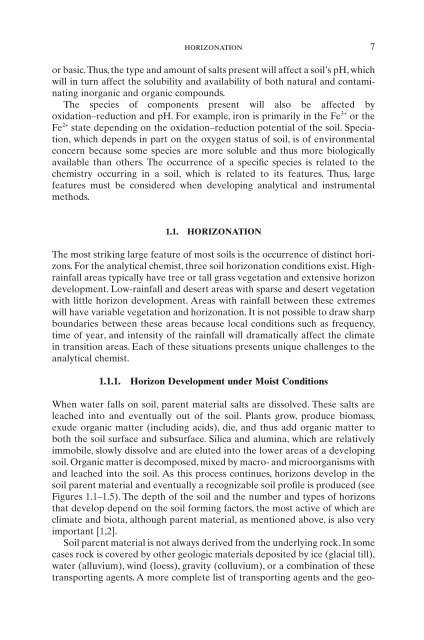Introduction to Soil Chemistry
Introduction to Soil Chemistry
Introduction to Soil Chemistry
Create successful ePaper yourself
Turn your PDF publications into a flip-book with our unique Google optimized e-Paper software.
horizonation 7<br />
or basic.Thus, the type and amount of salts present will affect a soil’s pH, which<br />
will in turn affect the solubility and availability of both natural and contaminating<br />
inorganic and organic compounds.<br />
The species of components present will also be affected by<br />
oxidation–reduction and pH. For example, iron is primarily in the Fe 3+ or the<br />
Fe 2+ state depending on the oxidation–reduction potential of the soil. Speciation,<br />
which depends in part on the oxygen status of soil, is of environmental<br />
concern because some species are more soluble and thus more biologically<br />
available than others. The occurrence of a specific species is related <strong>to</strong> the<br />
chemistry occurring in a soil, which is related <strong>to</strong> its features. Thus, large<br />
features must be considered when developing analytical and instrumental<br />
methods.<br />
1.1. HORIZONATION<br />
The most striking large feature of most soils is the occurrence of distinct horizons.<br />
For the analytical chemist, three soil horizonation conditions exist. Highrainfall<br />
areas typically have tree or tall grass vegetation and extensive horizon<br />
development. Low-rainfall and desert areas with sparse and desert vegetation<br />
with little horizon development. Areas with rainfall between these extremes<br />
will have variable vegetation and horizonation. It is not possible <strong>to</strong> draw sharp<br />
boundaries between these areas because local conditions such as frequency,<br />
time of year, and intensity of the rainfall will dramatically affect the climate<br />
in transition areas. Each of these situations presents unique challenges <strong>to</strong> the<br />
analytical chemist.<br />
1.1.1. Horizon Development under Moist Conditions<br />
When water falls on soil, parent material salts are dissolved. These salts are<br />
leached in<strong>to</strong> and eventually out of the soil. Plants grow, produce biomass,<br />
exude organic matter (including acids), die, and thus add organic matter <strong>to</strong><br />
both the soil surface and subsurface. Silica and alumina, which are relatively<br />
immobile, slowly dissolve and are eluted in<strong>to</strong> the lower areas of a developing<br />
soil. Organic matter is decomposed, mixed by macro- and microorganisms with<br />
and leached in<strong>to</strong> the soil. As this process continues, horizons develop in the<br />
soil parent material and eventually a recognizable soil profile is produced (see<br />
Figures 1.1–1.5). The depth of the soil and the number and types of horizons<br />
that develop depend on the soil forming fac<strong>to</strong>rs, the most active of which are<br />
climate and biota, although parent material, as mentioned above, is also very<br />
important [1,2].<br />
<strong>Soil</strong> parent material is not always derived from the underlying rock. In some<br />
cases rock is covered by other geologic materials deposited by ice (glacial till),<br />
water (alluvium), wind (loess), gravity (colluvium), or a combination of these<br />
transporting agents. A more complete list of transporting agents and the geo
















